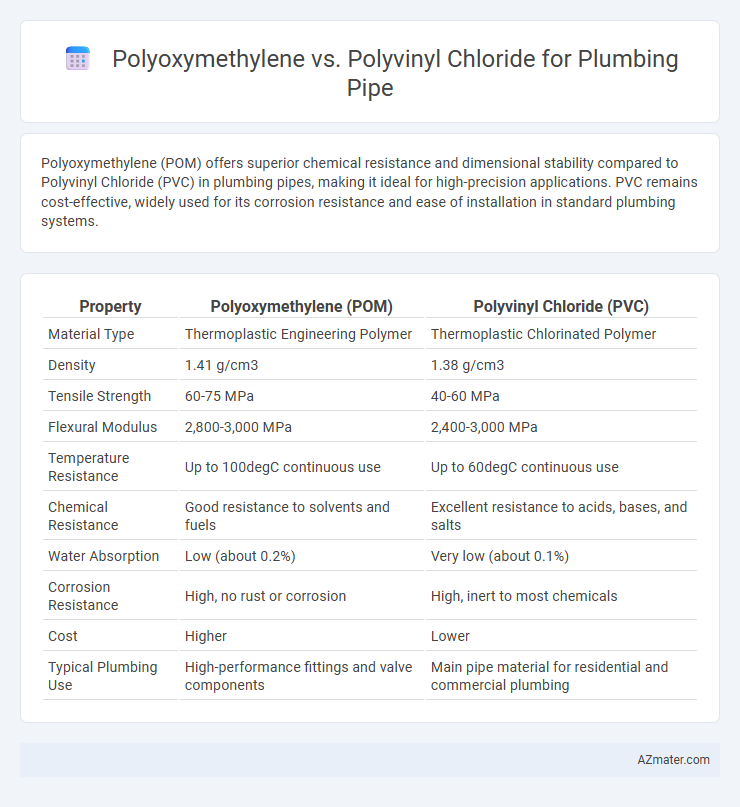Polyoxymethylene (POM) offers superior chemical resistance and dimensional stability compared to Polyvinyl Chloride (PVC) in plumbing pipes, making it ideal for high-precision applications. PVC remains cost-effective, widely used for its corrosion resistance and ease of installation in standard plumbing systems.
Table of Comparison
| Property | Polyoxymethylene (POM) | Polyvinyl Chloride (PVC) |
|---|---|---|
| Material Type | Thermoplastic Engineering Polymer | Thermoplastic Chlorinated Polymer |
| Density | 1.41 g/cm3 | 1.38 g/cm3 |
| Tensile Strength | 60-75 MPa | 40-60 MPa |
| Flexural Modulus | 2,800-3,000 MPa | 2,400-3,000 MPa |
| Temperature Resistance | Up to 100degC continuous use | Up to 60degC continuous use |
| Chemical Resistance | Good resistance to solvents and fuels | Excellent resistance to acids, bases, and salts |
| Water Absorption | Low (about 0.2%) | Very low (about 0.1%) |
| Corrosion Resistance | High, no rust or corrosion | High, inert to most chemicals |
| Cost | Higher | Lower |
| Typical Plumbing Use | High-performance fittings and valve components | Main pipe material for residential and commercial plumbing |
Introduction to Polyoxymethylene and Polyvinyl Chloride
Polyoxymethylene (POM), also known as acetal, is a highly crystalline engineering thermoplastic known for its excellent mechanical strength, low friction, and superior dimensional stability, making it ideal for precision plumbing components. Polyvinyl Chloride (PVC) is a widely used thermoplastic polymer characterized by its chemical resistance, affordability, and ease of installation, commonly employed in residential and commercial plumbing systems. Comparing POM and PVC reveals distinct advantages, with POM offering enhanced durability and flexibility under stress, while PVC provides cost-effective and corrosion-resistant solutions for standard pipe applications.
Chemical Structure and Material Composition
Polyoxymethylene (POM) consists of repeating formaldehyde units, forming a highly crystalline, thermoplastic polymer known for its rigidity, low friction, and chemical resistance, making it suitable for precision plumbing applications. Polyvinyl Chloride (PVC) is composed of vinyl chloride monomers, featuring a polymer backbone with chlorine atoms that impart durability, flame resistance, and chemical inertness in various environmental conditions. The chemical structure differences result in POM exhibiting superior mechanical strength and resistance to abrasion, while PVC offers better resistance to acids, alkalis, and UV exposure, influencing their respective suitability in plumbing pipe systems.
Mechanical Strength Comparison
Polyoxymethylene (POM) exhibits superior mechanical strength compared to Polyvinyl Chloride (PVC), offering higher tensile strength and greater stiffness, which ensures enhanced durability under pressure in plumbing applications. POM's excellent impact resistance and low creep characteristics contribute to its ability to withstand dynamic loads and thermal expansion better than PVC pipes. While PVC provides adequate performance in many plumbing systems, POM is preferred for scenarios demanding higher mechanical integrity and long-term reliability.
Thermal Performance and Temperature Resistance
Polyoxymethylene (POM) offers superior thermal performance with a melting point around 175degC, maintaining dimensional stability and resisting deformation under high temperatures common in hot water plumbing systems. Polyvinyl Chloride (PVC) has a lower maximum continuous use temperature, typically around 60degC to 70degC, making it less suitable for high-temperature applications but adequate for cold and warm water distribution. POM's excellent thermal resistance allows for greater durability and longer lifespan in plumbing systems exposed to fluctuating or elevated temperatures compared to PVC.
Corrosion and Chemical Resistance
Polyoxymethylene (POM) exhibits superior corrosion resistance compared to Polyvinyl Chloride (PVC), making it highly effective in plumbing applications exposed to aggressive chemicals and varying pH levels. POM's molecular structure provides enhanced durability against alkalis, solvents, and acids, reducing degradation and extending pipe lifespan. PVC, while resistant to many chemicals, is more susceptible to stress cracking and chemical attack in harsh environments, limiting its long-term performance in corrosive plumbing systems.
Ease of Fabrication and Installation
Polyoxymethylene (POM) offers superior ease of fabrication and installation compared to Polyvinyl Chloride (PVC) due to its excellent machinability and dimensional stability, allowing precise cutting and molding without deformation. POM pipes enable faster assembly with reduced joint sealant requirements, as their inherent chemical resistance and low friction surface minimize leakage risks. PVC pipes, while widely used, often require additional preparation like solvent welding and priming, which can complicate installation and extend labor time.
Cost Analysis and Economic Feasibility
Polyoxymethylene (POM) pipes generally incur higher initial material costs compared to Polyvinyl Chloride (PVC) pipes due to advanced manufacturing processes and superior mechanical properties. However, the long-term economic feasibility of POM is enhanced by its greater durability, chemical resistance, and reduced maintenance requirements, which can lower total life cycle costs. PVC remains cost-effective for standard plumbing applications where budget constraints and ease of installation are critical factors.
Environmental Impact and Sustainability
Polyoxymethylene (POM) offers a lower environmental footprint compared to Polyvinyl Chloride (PVC) due to its higher recyclability and reduced release of toxic chemicals during production and disposal. PVC manufacturing involves hazardous additives like phthalates and chlorine, contributing to environmental pollution and health risks, whereas POM is free from chlorine, enhancing its sustainability profile. The biodegradability of POM remains limited, but its increased recyclability and fewer harmful emissions make it a more eco-friendly choice for plumbing pipe applications.
Common Plumbing Applications
Polyoxymethylene (POM) offers superior chemical resistance and low friction, making it ideal for precision plumbing components and fittings in water distribution systems. Polyvinyl Chloride (PVC) is widely used for its cost-effectiveness, corrosion resistance, and ease of installation in residential and commercial drainage and irrigation pipes. Both materials serve critical roles, with POM preferred for durable connectors and PVC favored for extensive pipe networks in common plumbing applications.
Final Recommendations and Choosing the Right Material
Polyoxymethylene (POM) offers superior chemical resistance, low friction, and high mechanical strength, making it ideal for high-performance plumbing applications requiring durability and precision. Polyvinyl Chloride (PVC) is cost-effective, widely available, and resistant to corrosion and chemicals, suitable for standard residential water and waste systems. For critical installations demanding longevity and resistance to wear, POM is recommended, whereas PVC serves well in budget-sensitive projects with moderate operational demands.

Infographic: Polyoxymethylene vs Polyvinyl Chloride for Plumbing Pipe
 azmater.com
azmater.com